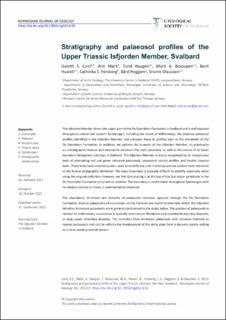| dc.contributor.author | Lord, Gareth Steven | |
| dc.contributor.author | Mørk, Atle | |
| dc.contributor.author | Haugen, Turid | |
| dc.contributor.author | Boxaspen, Marit Ann | |
| dc.contributor.author | Husteli, Berit | |
| dc.contributor.author | Forsberg, Cathinka Schaanning | |
| dc.contributor.author | Heggem, Bård | |
| dc.contributor.author | Olaussen, Snorre | |
| dc.date.accessioned | 2023-03-16T12:01:53Z | |
| dc.date.available | 2023-03-16T12:01:53Z | |
| dc.date.created | 2022-12-20T22:08:35Z | |
| dc.date.issued | 2022 | |
| dc.identifier.issn | 2387-5844 | |
| dc.identifier.uri | https://hdl.handle.net/11250/3058759 | |
| dc.description.abstract | The Isfjorden Member forms the upper part of the De Geerdalen Formation in Svalbard and is well exposed throughout central and eastern Spitsbergen, including the island of Wilhelmøya. We examine palaeosol profiles identified in the Isfjorden Member and compare these to profiles seen in the remainder of the De Geerdalen Formation. In addition, we address the nuances of the Isfjorden Member, its practicality as a stratigraphic interval and attempt to constrain the unit’s presence, as well as the nature of its lower boundary throughout outcrops in Svalbard. The Isfjorden Member is easily recognised by its conspicuous beds of alternating red and green coloured palaeosols, occasional caliche profiles and bivalve coquina beds. These beds have commonly been used to identify the unit in outcrop and we explore their relevance to the formal stratigraphic definition. The lower boundary is typically difficult to identify, especially when using the original definition; however, we find that placing it at the top of the last major sandstone in the De Geerdalen Formation is a practical solution. The boundary is conformable throughout Spitsbergen with no obvious erosion or break in sedimentation observed.The abundance, thickness and maturity of palaeosols increases upwards through the De Geerdalen Formation. Mature palaeosol and occasional caliche horizons are found to dominate within the Isfjorden Member. Immature palaeosols are in general constrained to the strata below. The position of palaeosols in relation to sedimentary successions is typically restricted to floodplain and interdistributary bay deposits, or atop upper shoreface deposits. The transition from immature palaeosols with common histosols to mature palaeosols and caliche reflects the development of the delta plain from a dynamic paralic setting to a morestable proximal system. | en_US |
| dc.language.iso | eng | en_US |
| dc.publisher | Geological Society of Norway | en_US |
| dc.rights | Navngivelse 4.0 Internasjonal | * |
| dc.rights.uri | http://creativecommons.org/licenses/by/4.0/deed.no | * |
| dc.title | Stratigraphy and palaeosol profiles of the Upper Triassic Isfjorden Member, Svalbard | en_US |
| dc.type | Journal article | en_US |
| dc.type | Peer reviewed | en_US |
| dc.description.version | publishedVersion | en_US |
| dc.rights.holder | Copyright 2022 The Author(s) | en_US |
| dc.source.articlenumber | 202215 | en_US |
| cristin.ispublished | true | |
| cristin.fulltext | original | |
| cristin.qualitycode | 1 | |
| dc.identifier.doi | 10.17850/njg102-4-02 | |
| dc.identifier.cristin | 2096012 | |
| dc.source.journal | Norwegian Journal of Geology | en_US |
| dc.identifier.citation | Norwegian Journal of Geology. 2022, 102, 202215. | en_US |
| dc.source.volume | 102 | en_US |

